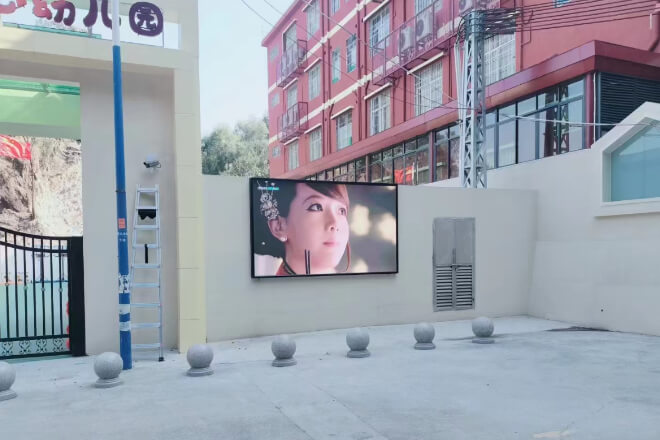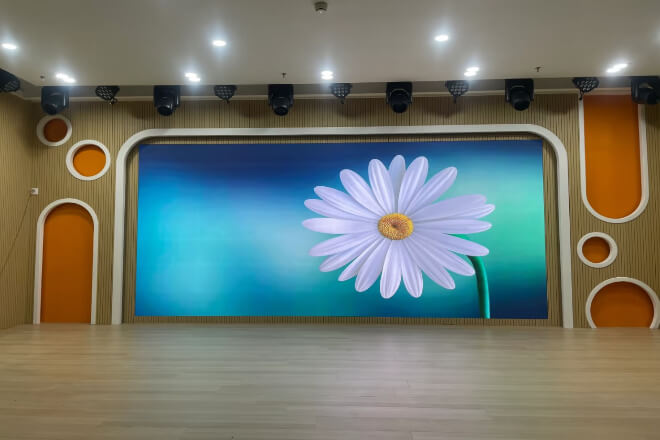Introduction
LED screens have become an indispensable educational tool in kindergartens. But did you know? Choosing and using an LED screen is a complex subject!
How can you ensure it’s safe, engaging, and truly supports children’s development? Let’s explore the key points about using LED screens in kindergartens!
Table of Contents
Note 1: Electrical safety is the top priority

When installing LED screens in kindergartens, safety is paramount. Remember, children are naturally curious and want to touch and bump into everything.
If the screen’s casing has sharp corners or is made of environmentally unsuitable materials, it’s like placing a hidden hazard in their play area.
For this reason, it’s best to have rounded corners on the screen casing, and the material should be environmentally friendly, odorless.
And flame-retardant, ensuring it’s less susceptible to problems even with minor friction or high temperatures.
As for the power supply, avoid using conventional high-voltage power supplies for LED screens in kindergartens.
Low-voltage power supplies are more suitable. This minimizes the risk of children accidentally approaching or touching the screen.
It’s best to hide all wires and power boxes to prevent them from being pulled by curious children and to create a cleaner, cleaner environment. Adding a leak-proof design provides peace of mind for teachers and parents.
Another often overlooked aspect is the screen’s impact resistance. With children running around in kindergarten, it’s common for them to accidentally bump into the screen.
If the screen’s surface is hard and fragile, it could shatter or even fall, which could be extremely dangerous.
Therefore, LED screens must have a certain degree of impact resistance. When installing, choose a built-in or sturdy wall-mounted installation to avoid turning the screen into a “big toy” for children.
Ultimately, using an LED screen in a kindergarten is more than just adding a display; it becomes part of the children’s daily environment.
Only by ensuring safety can it truly fulfill its educational and display functions, rather than causing teachers to worry daily.
Note 2: The brightness and color temperature of the LED screen should be adapted to children's vision.

In kindergartens, don’t just pick a blindingly bright LED screen. Children’s eyes are still developing.
If the screen’s brightness is too strong or the color temperature is uncomfortable, prolonged viewing can cause irritation, eye fatigue, and even affect vision development.
Ideally, choose a screen with adjustable brightness or an automatic light sensor that automatically adjusts brightness and dimming based on changes in classroom lighting.
This way, whether it’s cloudy or sunny, children won’t squint or be bothered by flickering.
Color temperature is also crucial. It’s recommended to keep it between 4000K and 5000K.
This range creates a softer, warmer, and more natural appearance, neither slanting toward blue nor toward yellow, and it won’t strain children’s eyes.
Most importantly, the screen must be flicker-free. While adults may not notice it, children staring at it for extended periods can easily cause eye fatigue and even headaches.
For safety reasons, it’s more reassuring to choose TÜV-certified screens. These products have strict standards for brightness and flicker control, providing peace of mind for teachers and parents.
To put it bluntly, an LED screen isn’t just a display device in the classroom; it’s an integral part of a child’s field of vision.
A screen with soft brightness, a moderate color temperature, and no flickering allows children to watch animations and learn in a safe and comfortable environment, rather than having to rub their eyes while watching flickering images.
This way, the screen can both educate and entertain without putting invisible strain on children’s eyesight.
Note 3: Display content should be engaging and engaging.

In kindergartens, LED displays are more than just attractive electronic boards; they are magical little wizards that capture children’s attention. To keep children glued to the screen, the content must be engaging and entertaining.
Long, drawn-out text? Come on, children won’t have the patience to read through an entire paragraph.
Instead, use cute cartoon characters, lively animations, and clear, concise icons—easy to understand at a glance and inviting for children to revisit.
Screens can be used for many purposes, beyond just playing animations. They can display the class schedule, letting children know what classes they’ll be attending.
Holiday notices and parent-child activity previews can also be presented vividly, allowing parents and children to experience the kindergarten atmosphere.
If the screen supports interactive audio and video playback, the effect is even better—children will naturally be absorbed in watching animated characters speak, sing, or move.
In short, LED screens in kindergartens serve as both information assistants and fun companions.
As long as the content is vivid and the colors and animations are engaging, they can keep children engaged and even become a source of enjoyment outside the classroom.
Note 4: Install away from children's play areas

Installing an LED screen in a kindergarten is not as simple as hanging it up in any corner. Children are naturally curious and want to touch and bump everything.
Installing the screen low or in areas where children are active creates a dangerous environment.
LED screens are best installed away from children’s play areas to ensure safety and clear visibility.
Parental drop-off areas, entrances, or high in hallways are good options. While parents can easily access notifications, children can only view from a distance, out of reach, reducing the risk of accidental touch or bumps.
The supporting structure of the installation is also crucial. The wall or mounting bracket must be sturdy and reliable, with a seismic resistance rating that meets standards to withstand children running, jumping, or accidentally bumping into it.
Screws, brackets, and fasteners must be selected in strict accordance with safety regulations and properly secured against loosening.
Protective covers or guardrails can be added if necessary. This ensures the long-term stability of the screen and prevents the safety hazards of accidental drops.
More importantly, the installation location and mounting method directly impact children’s interactive experience with the screen.
A slightly higher screen allows children to see less close-up details, but the overall image and animation remain clear.
Teachers and parents also avoid constant worry about damage to the screen, allowing them to focus more on children’s activities and instruction.
In general, choosing a high, secure installation away from activity areas not only maximizes the effectiveness of the LED screen but also makes it a safe, stable.
And practical tool for kindergartens, ensuring both information dissemination and engaging displays.
Note 5: Content management on LED displays should be reviewed by a dedicated person.

In kindergartens, LED displays are not just for casual placement; they are directly in front of children’s eyes and minds.
Therefore, content management must be managed by a dedicated person, preferably a teacher or school administrator.
Every message, animation, and image should be screened to ensure it’s healthy, safe, and educational.
Commercial advertisements, uncontrolled information, or images inappropriate for young children must be strictly prohibited.
This is not only a safety issue but also impacts children’s values and attention development.
To make management easier and prevent oversight, it’s best to have a timed playback mechanism or remote update function for the screen.
For example, schedules, holiday events, and parent-child interactions can be automatically scheduled, eliminating the need for frequent teacher input.
New content can also be uploaded remotely, updating the screen with a single click, making it both hassle-free and efficient.
This not only ensures the safety and appropriateness of the content, but also allows children to see fresh, interesting, and educational content every day.
Making the screen a true part of the kindergarten experience, rather than just a random “electronic board.”
In short, with dedicated oversight and a mechanism to ensure updates, kindergarten LED displays can be both safe and practical, delivering information while supporting children’s joyful growth.
6. Conclusion
With the above considerations, I believe you now have a more comprehensive understanding of LED screens for kindergartens.
Safety, fun, and appropriateness are not only requirements for the equipment, but also for the environment in which children grow.
We hope these tips will help you create a better learning space for your children!
Finally, if you would like to learn more about LED screens, please contact us.
